The older parts of the city are dotted with amazing Euro-Spanish architecture, the restaurants are filled with steaks and wine, the bars and clubs are lively with Latin music, Tango dancing and patrons who are always up for a good time. The city literally never sleeps. Whether it´s 4AM on a Saturday night, or 2AM on a Wednesday, there are people in the street and restaurants and clubs that are open.
We decided to stay in an older part of town called San Telmo, known for it´s Tango culture and historic architecture. In the course of a week, we got a small taste of the best of BA...and know for certain that this is a place we will return to. Here are some of our favorite experiences:
Spanish Class
Since we´d both learned some Spanish in the past, and since we are going to be in Spanish 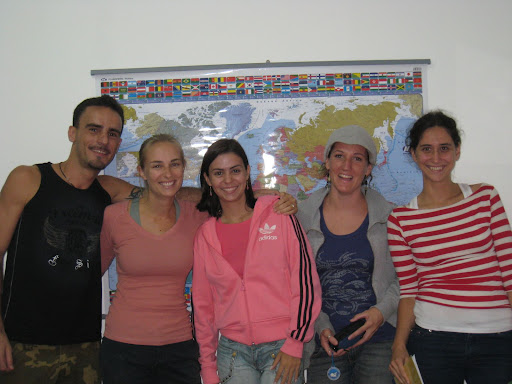 speaking countries for 3 months, we decided it was a priority to take some lessons to brush up on our basic skills and build a foundation for further learning as we travel. We signed up for a week of small group lessons (Mon-Fri from 9AM-1:30PM) at a local language school called IBL.
speaking countries for 3 months, we decided it was a priority to take some lessons to brush up on our basic skills and build a foundation for further learning as we travel. We signed up for a week of small group lessons (Mon-Fri from 9AM-1:30PM) at a local language school called IBL.
While the time commitment did eat up a lot of our "tourist" time during the day (and waking up every morning at 7:30AM was killer), we were both glad we did it. We reviewed grammar rules, increased our vocab and got some good speaking practice over the course of the week. We also met some really great people in our classes from Brazil, Holland, the UK, and the US. Eric´s classmate Jayme (from Brazil) became a quick friend and we toured around the city and went out with him throughout the week. Admittedly, we probably won´t be fluent by the time we get home, but we will certainly be "proficent" - or at least we hope!
The Food/Drink
While Argentina is not necessarily known for the most flavorful cuisine - they are famous for 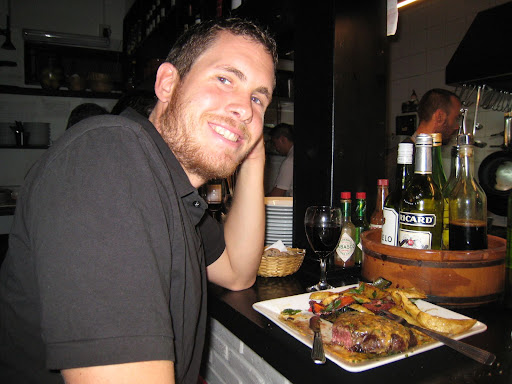 their steaks and wine - and for good reason! No doubt about it, these people are carnivores and love their red meat. There are parillas on every block serving up steaks, asado (traditional meat dish), chorizo, sausage and much more. The norm on the menu is a hunk of red meat with french fries or potatoes. And trust us, it´s very good. We found a number of great local places to get quality steak for between $5-10.
their steaks and wine - and for good reason! No doubt about it, these people are carnivores and love their red meat. There are parillas on every block serving up steaks, asado (traditional meat dish), chorizo, sausage and much more. The norm on the menu is a hunk of red meat with french fries or potatoes. And trust us, it´s very good. We found a number of great local places to get quality steak for between $5-10.
In addition to the steak joints, there are also a handful of other gourmet restaurants that have more variety on the menu and a nice touch of clas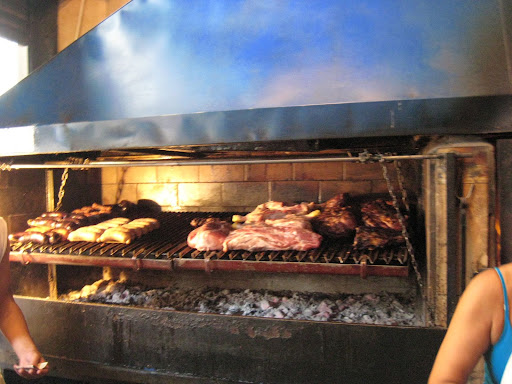 s. We splurged a couple times (spending $30-40 on a nice meal with wine) to treat ourselves to the finer things in life. Although, I think Eric ordered steak pretty much everywhere we went.
s. We splurged a couple times (spending $30-40 on a nice meal with wine) to treat ourselves to the finer things in life. Although, I think Eric ordered steak pretty much everywhere we went.
And of course, Argentina is known for their wine country near Cordoba and Mendoza in the central part of the country...producing many great wines. We shared quite a few bottles of red wine over the course of the week and each one was excellent.
The Bars/Clubs
Many a traveler has raved about the awesome night life in BA, but until you are here, you just can´t understand. Even I - a girl who likes her sleep and is more of a homebody - wanted to go out every night. There are so many cool places to go...from clubs pumping techno and pop music, to music venues with live bands, from funky cafes and pubs to swanky upscale bars. There is something for everyone...and some place for every mood every 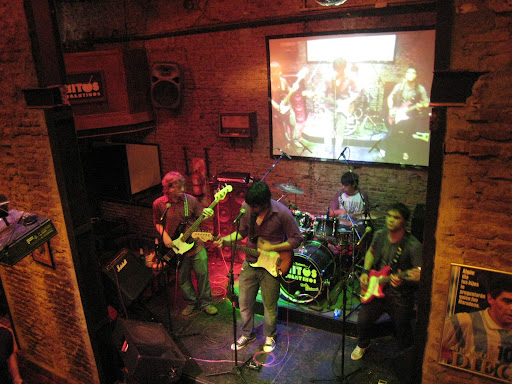 night of the week. While we were slightly strapped due to our early morning wake-ups, we still managed to get out most nights to see some great local bands, dance the night away, or sit chatting away in a local pub.
night of the week. While we were slightly strapped due to our early morning wake-ups, we still managed to get out most nights to see some great local bands, dance the night away, or sit chatting away in a local pub.
Two of our favorite evenings was a Saturday night spent listening to 3 local bands - all with a bit different sound. We met some locals there to support their friends in the bands and even bought a couple of the CDs. And a Friday night spent with our friends Cristian (from Chile) and Jose Luis (from Spain) at a Cuban restaurant/bar called Rey Castro. We had a great 3 course Cuban meal followed by live Cuban music and dancing. It was a blast!
Tango
One thing is very clear when you arrive to BA - Tango music and dancing are at the heart and soul of this city. Everywhere you turn...the street corner, restaurants, bars, live shows...T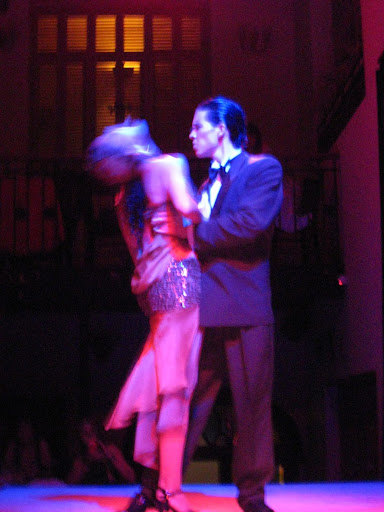 ango is present. We thoroughly enjoyed listening to live Tango music on the streets and seeing people dancing at local Milongas (essentially Tango joints) or pretty much any where there is music and space. To get a full Tango experience, we decided to attend a Tango dinner show with our friend Jayme from Spanish class. Complejo Tango offered a free Tango lesson the hour prior to the dinner show where we got to test our beginner skills...and we actually weren´t too terribly bad considering it was our first lesson. The actual show and live music were phenomenal and quite impressive. We sat there in awe watching the dancer´s feet as they performed many complex and graceful moves. It´s good to take the lesson beforehand because even though they make it look so darn easy, you realize how much talent and practice it takes!
ango is present. We thoroughly enjoyed listening to live Tango music on the streets and seeing people dancing at local Milongas (essentially Tango joints) or pretty much any where there is music and space. To get a full Tango experience, we decided to attend a Tango dinner show with our friend Jayme from Spanish class. Complejo Tango offered a free Tango lesson the hour prior to the dinner show where we got to test our beginner skills...and we actually weren´t too terribly bad considering it was our first lesson. The actual show and live music were phenomenal and quite impressive. We sat there in awe watching the dancer´s feet as they performed many complex and graceful moves. It´s good to take the lesson beforehand because even though they make it look so darn easy, you realize how much talent and practice it takes!
Football (i.e., Soccer)
For those of you who don´t know, Argentineans are football fanatics! One of their most popular teams in Boca Juniors 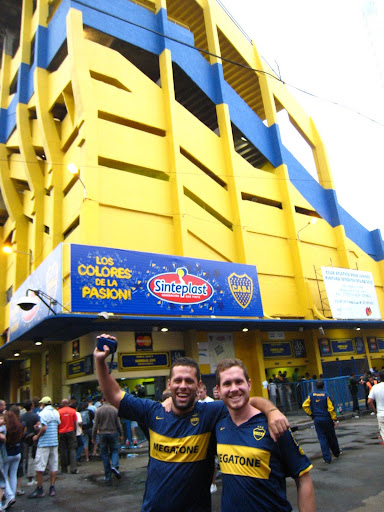 representing the BA barrio of La Boca. There is one group of fans that is so dedicated to this team (and present at every game) that they call the cheering section the "twelfth player." We were lucky enough to get to go to one of the games to experience the fanaticism ourselves. Standing in the public cheering section (across the stadium from the even crazier twelfth player), we joined in the singing, stomping, jumping, hollering, swaying, etc. The energy in that stadium was enough to fly y
representing the BA barrio of La Boca. There is one group of fans that is so dedicated to this team (and present at every game) that they call the cheering section the "twelfth player." We were lucky enough to get to go to one of the games to experience the fanaticism ourselves. Standing in the public cheering section (across the stadium from the even crazier twelfth player), we joined in the singing, stomping, jumping, hollering, swaying, etc. The energy in that stadium was enough to fly y ou to the moon. I have been at some great USC football games where the fans go wild, but never have I been to a game where the entire stadium - literally - is singing and jumping/swaying together in complete unison making so much noise you can´t hear anything. And, the Boca Juniors won 3-0 against the Mexican team Atlas, so it was a great close to the night.
ou to the moon. I have been at some great USC football games where the fans go wild, but never have I been to a game where the entire stadium - literally - is singing and jumping/swaying together in complete unison making so much noise you can´t hear anything. And, the Boca Juniors won 3-0 against the Mexican team Atlas, so it was a great close to the night.
 ou to the moon. I have been at some great USC football games where the fans go wild, but never have I been to a game where the entire stadium - literally - is singing and jumping/swaying together in complete unison making so much noise you can´t hear anything. And, the Boca Juniors won 3-0 against the Mexican team Atlas, so it was a great close to the night.
ou to the moon. I have been at some great USC football games where the fans go wild, but never have I been to a game where the entire stadium - literally - is singing and jumping/swaying together in complete unison making so much noise you can´t hear anything. And, the Boca Juniors won 3-0 against the Mexican team Atlas, so it was a great close to the night.Sightseeing/Shopping
While we didn´t get as much time as we wanted to see all the sights around BA, we did get a 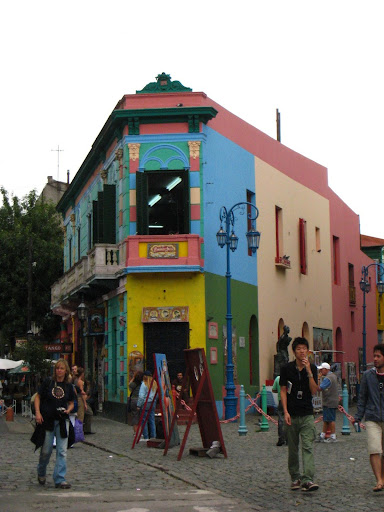 chance to visit a few of the major "must sees," including: the Recoleta cemetery filled with crypts and large tombs of the rich and famous (including Evita); the
chance to visit a few of the major "must sees," including: the Recoleta cemetery filled with crypts and large tombs of the rich and famous (including Evita); the 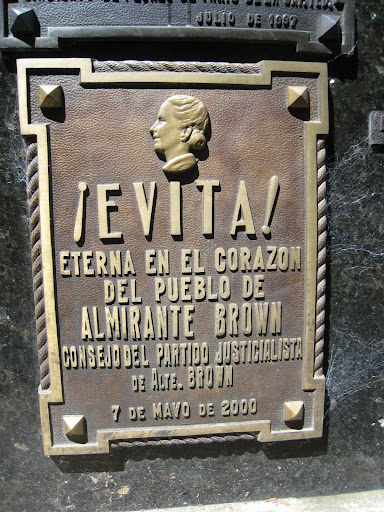 famous street of Caminito lined with rainbow colored houses and shop fronts, Tango dancers and artisans selling crafts and paintings; the Playa del Mayo where social activists gather; in addition to a few other spots.
famous street of Caminito lined with rainbow colored houses and shop fronts, Tango dancers and artisans selling crafts and paintings; the Playa del Mayo where social activists gather; in addition to a few other spots.
But the touristy day we enjoyed the most was right at our hostel´s front door in San Telmo. Every Sunday, there is a huge antiques and handicraft market in the streets and plaza of San Telmo. There were dozens of street performers, of course lots of Tango music and dancing, and hundreds of booths selling souvenirs we couldn´t resist. We decided to buy a boxful of goodies to ship home - telling ourselves that it´s worth it because, seriously, how often are we in Argentina? :) We are such suckers!
What´s Next...
So after about a week of non-stop fun and activity, we flew to Patagonia to begin our hiking and outdoor adventures in the most Southerly city in the world, Ushuaia. I have a feeling we will need a couple days of R&R - with a couple day hikes to get in shape again - to recover from last week. Then from here, we will be working our way up North through Argentina, Chile and finally to Peru. We plan to return to BA for a few days near the end of our trip because it turns out it´s the cheapest city to fly home from. So we figured we´d spend a few more days in BA (without early mornings for Spanish classes) to see some other parts of the city we didn´t have time to explore. More adventures to come...